Roden's 1/72 Gotha G.II/G.III By Steve Hustad | | World War I aircraft modelers have bemoaned the lack of 'big bomber' kits of the Great War for quite some time now. In 1/48th scale, those poor sods have had to deal with the ancient and grossly inaccurate Aurora/K&B offering for countless years. And in 1/72nd, we're not much better served until around 1983 when Rareplanes brought out their superb vacform Gotha G.IV/V kit. There have also been a few 'one-off' attempts in resin that I haven't seen and I hear that another vac is also reported(?). All of these others I'm not familiar with and can't comment on. 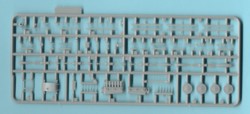 Now from Ukraine, we have Roden's 1/72nd scale Gotha G.II/G.III kit. This kit contains 234 pieces molded in a soft 'warm' light gray plastic, plus 12 in clear. It's interesting to note that 89 of those parts are slated for 'non-use' - indicating future variants forthcoming. The kit also comes with an extensive 12-page instruction sheet that indicates three specific aircraft that may be produced (one G.II and two G.IIIs). Now from Ukraine, we have Roden's 1/72nd scale Gotha G.II/G.III kit. This kit contains 234 pieces molded in a soft 'warm' light gray plastic, plus 12 in clear. It's interesting to note that 89 of those parts are slated for 'non-use' - indicating future variants forthcoming. The kit also comes with an extensive 12-page instruction sheet that indicates three specific aircraft that may be produced (one G.II and two G.IIIs).
Decals are included so the modeler may build any of the ones illustrated, but only one set of national markings are on the sheet - all in black & white (only). Note that these are the same crates illustrated in color in the book "Gotha!" as plates A, B & C. As a forewarning, I've chosen as my primary reference for this kit review to be the book "Gotha!" and it's plans by I.R. Stair. The book contains plans for the Gotha G.III (and later variants), but not the G.II. So we'll rely on photos for those differences. The overall dimensions of the two types are virtually identical, the differences being restricted to powerplants, propellers and other mostly minor external details. This kit is clearly more of a G.III than a G.II. Let's go through it subassembly by subassembly: 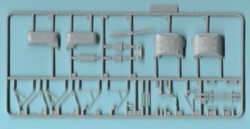 Starting with the fuselage: Starting with the fuselage:
Laying it against the Gotha! plans shows that the kit parts (including the tailplane & rudder length) are 4mm longer than the drawings. The plans equate nicely with the real plane's published dimensions here being only 1mm too long. I think the kit is a bit short, but nothing that would be noticed. I wouldn't attempt a correction here. Shape and outline appear accurate and the surface detail is delicate. However some surface detail does not seem to show up on the Gotha! plans, or in the numerous photographs. Comparison with the specific crate you're building is advised! Now into the cockpit: 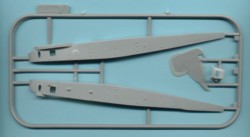 There are four bulkheads, no floorboard, three "seats", control column & wheel, bomb racks (2), rudder pedals and instrument panel as well as a closure top/forward fuselage piece. Two of the seats are rear & forward fold down affairs (they're okay), the other being the pilot's seat (chunky and best replaced). The rear bulk head opening - and the under fuselage cut out to the rear of it is incorrect for a G.II because that type was not outfitted with a machine gun firing down through the fuselage to the rear. A dry fit of the cockpit parts appears acceptable, although the rudder pedals, control column and control wheel are all too thick and over scale and require replacement for an accurate scale effect. There are four bulkheads, no floorboard, three "seats", control column & wheel, bomb racks (2), rudder pedals and instrument panel as well as a closure top/forward fuselage piece. Two of the seats are rear & forward fold down affairs (they're okay), the other being the pilot's seat (chunky and best replaced). The rear bulk head opening - and the under fuselage cut out to the rear of it is incorrect for a G.II because that type was not outfitted with a machine gun firing down through the fuselage to the rear. A dry fit of the cockpit parts appears acceptable, although the rudder pedals, control column and control wheel are all too thick and over scale and require replacement for an accurate scale effect.
The fuselage interior sidewalls do have some molded in structure detail that is mostly acceptable, though uneven and slightly missing in spots. A problem here will be that each fuselage half contains three large and protruding ejector pin studs. These are best dealt with using the trusty 'ol Dremel motor tool outfitted with a grinding bit. This is too bad, because some of that sidewall structure will surely be lost…("don't call me Shirley!"…). 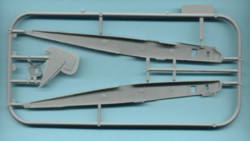 On to the main planes, beginning with the upper wing: On to the main planes, beginning with the upper wing:
Overall length appears to be about 6mm too long relative to the plans. This may be due to the upper wing's slight dihedral that will foreshorten it in plan view a bit. Again nothing serious and within generally accepted kit tolerances. It's interesting to note that the plans don't match the book's own stated dimensions exactly, being about 3mm short from stated dimensions - though nothing serious. The chord looks right on, though the prop cut outs are a bit different by about half a rib space. Who's right? - I can't say, but knowing the nature of Mr. Stair's talents I'm willing to give him the benefit of the doubt. In any case, these slight deviations will also not be noticed. The ribs are 'a bit off' compared to the plans as well, but do count out the same. The rib effect is quite well done, being raised and subtle topsides and ever so slightly convex on the undersides. Very effective and it looks the part. 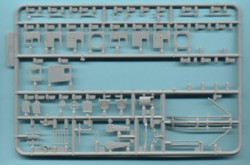 I should also note here that all 'fabric covered' flying surfaces have an artificial fabric weave texture. Some modelers detest this and think it's overdone (right Matt?), while others think it looks fine under a coat or two of paint. Me?, I'll give it a *light* sanding to bring it down a bit, but leave about half of it 'as is', because I don't think it looks too bad when toned down... I should also note here that all 'fabric covered' flying surfaces have an artificial fabric weave texture. Some modelers detest this and think it's overdone (right Matt?), while others think it looks fine under a coat or two of paint. Me?, I'll give it a *light* sanding to bring it down a bit, but leave about half of it 'as is', because I don't think it looks too bad when toned down...
The lower wing: Here we have a multi-part affair where the center section abuts the inside edges of the engine nacelles that in turn abut the outer wing sections. Overall, the lower wing appears to be about 8mm too long. But again, the plans don't dimension clearly, themselves being a few mm short of the stated dimension. And again it is a deviation that I would consider 'slight'. Final assembly will tell. As long as all of those interplane struts line up perfectly vertical I wouldn't worry about it. If it were over the span of a single engine fighter, I'd do something about it, but over this long span it will NEVER be noticed. Anyway, how'd you like to go to the trouble to shorten this span a little (and that would be no small amount of work!) only to find that none of your strut holes worked anymore? - Maybe the nacelles don't line up properly then? - No thanks! Assuming it all fits and lines up (a big assumption I know, but…), I'd leave well enough alone. 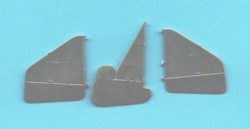 Wing tip shapes, chord depth, ribs and general outlines appear acceptably close to photos and plans, though I'm sure we could find one or two pedantic people who would disagree with me on this point. Disagree?!? With me?! (Insert 'shocked and wounded' voice here) - nooooo, never! Wing tip shapes, chord depth, ribs and general outlines appear acceptably close to photos and plans, though I'm sure we could find one or two pedantic people who would disagree with me on this point. Disagree?!? With me?! (Insert 'shocked and wounded' voice here) - nooooo, never!
The tailplane parts: Horizontal members are about 1 to 2mm short in chord, though shapes and spans are correct (with the plans that is…). Vertical stabilizers and rudders (one included for each variant) look good in outline and dimension, though these parts have the heaviest 'flash' present' in this kit. A swipe of sandpaper here and there will remedy the few very minor perimeter shape problems - better to 'remove plastic' than to have to *add* it I always say! The engines and their nacelles: Now here's an odd situation…the nacelles intended for the G.II/III are offered up for some surgery in the instructions. One must remove about 3/4ths of the louvers in order to make an accurate G.II/III nacelle. I thought; okay, they must be saving these for the next G.IV kit to come out. But a quick check of those plans and photos reveal that the G.IV also had far fewer louvers (the same in fact) as the G.II/III. So what's Roden up to here? I don't know but at least they're showing you what's' necessary (sigh…). The kit also includes the G.V nacelles marked for 'no-use'. I think they look decent and the correction is easy. 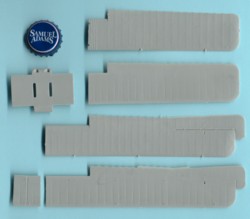 As to the engines, Included in the kit are two very nicely done Mercedes 260hp D.IVa - 6 cylinder inlines. Accurate for the G.III, but not the G.II that takes an 8-cylinder 220hp D.IV inline. You'll have to do some minor surgery to get the extra two added and correct. As to the engines, Included in the kit are two very nicely done Mercedes 260hp D.IVa - 6 cylinder inlines. Accurate for the G.III, but not the G.II that takes an 8-cylinder 220hp D.IV inline. You'll have to do some minor surgery to get the extra two added and correct.
Overall, the engines are quite nice and useable. About six parts make up each engine and all are well molded. Landing gear, wheels, bombs, tail skid and other small detail parts. These are all faithfully reproduced, even though some are quite small. I was very pleased to see that the small Parabellum machine guns were also well molded. The landing gear struts look quite delicate and to scale - this was especially impressive as these small strut like parts are usually the first to suffer 'scale creep' due to the limitations of the plastic molding process. Well done! The wheels also look good for most types; those may be a tiny bit undersized in diameter. The bombs look good, but I recommend their fins be replaced with brass. Tailskid is accurate for most types as well. All of the struts will require some clean up of flash, but look to scale as well. The clear parts are thick, but appear useable with the exception of part No.7 that has a significant molding flaw. But that might just be my copy (?) and may not even be intended for use on this model - hard to tell here, but in either case it's easily replaced with a piece of clear sheet plastic cut to shape. The instruction sheets contain detailed rigging plans - which also show the differences between the G.II and G.III types rigging (a nice touch). And are easier to follow than trying to locate enough vintage photos taken from 'just the right angle'! Also included are three, 3-view plans for colors and markings that appear to closely follow those color plates mentioned above in the book Gotha! The decals: 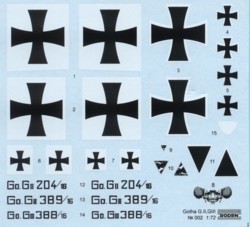 As mentioned above, these are for three plans (one set of national markings). They're all in black and white (only). The register appears to be 'spot on' and they look very thin…maybe TOO thin? We'll have to find out later I guess. I'd certainly give them a try, but be prepared with a back up plan if the tear, or hopelessly fold up on top of themselves like some other Eastern European decals are prone too! As mentioned above, these are for three plans (one set of national markings). They're all in black and white (only). The register appears to be 'spot on' and they look very thin…maybe TOO thin? We'll have to find out later I guess. I'd certainly give them a try, but be prepared with a back up plan if the tear, or hopelessly fold up on top of themselves like some other Eastern European decals are prone too!
All right, so what's the verdict you ask? I think that the molding quality of this kit this is a vast improvement over Roden's other recent efforts, despite there still being a ways to go in some areas. Very acceptable. The dimensional discrepancies (the ones I'm fairly certain of anyway) are minor and appear inconsequential. I don't think they're worth bothering with. I'd grade this kit a solid "B". And recommend that you rush right out and buy one! I'm sure that PART will come out with a mouth watering set of photoetched frets for this kit. It just cries out for replacement and enhancement of many of the more delicate pieces. The cockpit alone could be dramatically improved by PART. As to markings, I'd also recommend that you pick up the relevant sheets from Americal/Gryphon. Those are fantastic decals and well worth the detailed and informative booklet that comes with them. I don't know about you, but I'm ready for Roden to bring on those Gotha G.IVs and G.Vs now too! Our thanks to Roll Models for the review sample. | 


 



  
    |
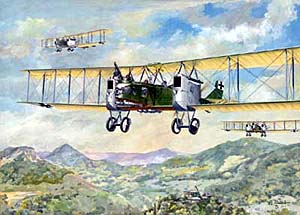
 Now from Ukraine, we have Roden's 1/72nd scale Gotha G.II/G.III kit. This kit contains 234 pieces molded in a soft 'warm' light gray plastic, plus 12 in clear. It's interesting to note that 89 of those parts are slated for 'non-use' - indicating future variants forthcoming. The kit also comes with an extensive 12-page instruction sheet that indicates three specific aircraft that may be produced (one G.II and two G.IIIs).
Now from Ukraine, we have Roden's 1/72nd scale Gotha G.II/G.III kit. This kit contains 234 pieces molded in a soft 'warm' light gray plastic, plus 12 in clear. It's interesting to note that 89 of those parts are slated for 'non-use' - indicating future variants forthcoming. The kit also comes with an extensive 12-page instruction sheet that indicates three specific aircraft that may be produced (one G.II and two G.IIIs).  Starting with the fuselage:
Starting with the fuselage: There are four bulkheads, no floorboard, three "seats", control column & wheel, bomb racks (2), rudder pedals and instrument panel as well as a closure top/forward fuselage piece. Two of the seats are rear & forward fold down affairs (they're okay), the other being the pilot's seat (chunky and best replaced). The rear bulk head opening - and the under fuselage cut out to the rear of it is incorrect for a G.II because that type was not outfitted with a machine gun firing down through the fuselage to the rear. A dry fit of the cockpit parts appears acceptable, although the rudder pedals, control column and control wheel are all too thick and over scale and require replacement for an accurate scale effect.
There are four bulkheads, no floorboard, three "seats", control column & wheel, bomb racks (2), rudder pedals and instrument panel as well as a closure top/forward fuselage piece. Two of the seats are rear & forward fold down affairs (they're okay), the other being the pilot's seat (chunky and best replaced). The rear bulk head opening - and the under fuselage cut out to the rear of it is incorrect for a G.II because that type was not outfitted with a machine gun firing down through the fuselage to the rear. A dry fit of the cockpit parts appears acceptable, although the rudder pedals, control column and control wheel are all too thick and over scale and require replacement for an accurate scale effect.  On to the main planes, beginning with the upper wing:
On to the main planes, beginning with the upper wing: I should also note here that all 'fabric covered' flying surfaces have an artificial fabric weave texture. Some modelers detest this and think it's overdone (right Matt?), while others think it looks fine under a coat or two of paint. Me?, I'll give it a *light* sanding to bring it down a bit, but leave about half of it 'as is', because I don't think it looks too bad when toned down...
I should also note here that all 'fabric covered' flying surfaces have an artificial fabric weave texture. Some modelers detest this and think it's overdone (right Matt?), while others think it looks fine under a coat or two of paint. Me?, I'll give it a *light* sanding to bring it down a bit, but leave about half of it 'as is', because I don't think it looks too bad when toned down...  Wing tip shapes, chord depth, ribs and general outlines appear acceptably close to photos and plans, though I'm sure we could find one or two pedantic people who would disagree with me on this point. Disagree?!? With me?! (Insert 'shocked and wounded' voice here) - nooooo, never!
Wing tip shapes, chord depth, ribs and general outlines appear acceptably close to photos and plans, though I'm sure we could find one or two pedantic people who would disagree with me on this point. Disagree?!? With me?! (Insert 'shocked and wounded' voice here) - nooooo, never!  As to the engines, Included in the kit are two very nicely done Mercedes 260hp D.IVa - 6 cylinder inlines. Accurate for the G.III, but not the G.II that takes an 8-cylinder 220hp D.IV inline. You'll have to do some minor surgery to get the extra two added and correct.
As to the engines, Included in the kit are two very nicely done Mercedes 260hp D.IVa - 6 cylinder inlines. Accurate for the G.III, but not the G.II that takes an 8-cylinder 220hp D.IV inline. You'll have to do some minor surgery to get the extra two added and correct. As mentioned above, these are for three plans (one set of national markings). They're all in black and white (only). The register appears to be 'spot on' and they look very thin…maybe TOO thin? We'll have to find out later I guess. I'd certainly give them a try, but be prepared with a back up plan if the tear, or hopelessly fold up on top of themselves like some other Eastern European decals are prone too!
As mentioned above, these are for three plans (one set of national markings). They're all in black and white (only). The register appears to be 'spot on' and they look very thin…maybe TOO thin? We'll have to find out later I guess. I'd certainly give them a try, but be prepared with a back up plan if the tear, or hopelessly fold up on top of themselves like some other Eastern European decals are prone too! 






